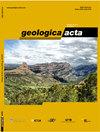Late-Variscan multistage hydrothermal processes unveiled by chemical ages coupled with compositiona.
IF 1.3
4区 地球科学
Q2 GEOLOGY
引用次数: 7
Abstract
The scheelite skarn from Los Santos and the W-Au veins from El Cabaco district, located in the Spanish Central System Batholith (SCSB), are some of the best-known tungsten ore deposits in Spain. Uraninite is an accessory mineral in both deposits, which underwent several hydrothermal flow events. Chemical and textural characteristics, as well as electron microprobe U-Th-Pb uraninite chemical data from the different stages of the skarn and the vein-type mineralizations, are presented here. Based on these data the uraninite was able to be classified into two groups. Group I uraninite has an octahedral habit and occurs as inclusions in K-feldspar relicts of the leucogranite related to Los Santos skarn formation. It shows high Th (6.95 to 8.51wt.% ThO 2 ) and high Rare Earth Elements (REEs) contents (0.55 to 1.38wt.% ∑REE 2 O 3 ). Group II uraninite occurs i) associated to El Cabaco granite, in a greenish selvage-style greisen and its reddish envelope and in the mineralized rimming quartz veins and ii) in Los Santos high-temperature endoskarn and anorthite skarn, where it is associated with U-rich mica. This uraninite type has lower Th and ∑REE 2 O 3 contents than Group-I uraninite. The mineral chemistry and the assemblage and textural relationships suggest that Group-I uraninite is magmatic and the attained U-Th-Pb chemical age of 300±4Ma is interpreted as the magmatic age of the skarn-forming aplite granites in the western part of the SCSB. Group-II uraninite includes two events: i) hydrothermal uraninite, which yields an age of 295±2Ma, dates a strong alkali mobilization and early tungsten deposition and ii) a later hydrothermal process, around 287±4Ma, that resulted in sulfides and late scheelite precipitation and widespread silicification. Finally, the gold deposition is younger than this silicification according to textural criteria. Therefore, W-Au deposits in the western part of the SCSB were formed by superposition of several processes that took place some 15Ma after the skarn-forming granite crystallized. Comparable W, W-Au and U deposits in the Variscan orogenic belt show a similar timing of hydrothermal events, suggesting that the hydrothermal history was controlled by large-scale Late-Variscan tectonic processes.晚期瓦里斯坎多阶段热液过程揭示了化学年龄与成分的耦合。
位于西班牙中央体系基岩(SCSB)的Los Santos白钨矿矽卡岩和El Cabaco地区的W-Au矿脉是西班牙最著名的钨矿床。铀矿是两个矿床的副矿物,均经历了多次热液流动事件。本文介绍了矽卡岩和脉状矿化不同阶段的化学和结构特征,以及电子探针U-Th-Pb铀矿化学数据。根据这些资料,可将铀矿分为两类。I类铀矿具有八面体习性,以包裹体形式赋存于与洛斯桑托斯夕卡岩形成有关的浅花岗岩的钾长石残余物中。高Th (6.95 ~ 8.51wt)。% ThO 2)和高稀土元素(ree)含量(0.55 ~ 1.38wt)。%∑ree 2 0 3)。II组铀矿产于i)与El Cabaco花岗岩伴生,呈绿色边沿型灰岩及其红色包膜,矿化边缘石英脉中;II)在Los Santos高温内矽卡岩和钙长岩矽卡岩中,与富铀云母伴生。该类铀矿具有较低的Th和∑REE 2o3含量。矿物化学、组合和结构关系表明,ⅰ群铀质岩为岩浆质,获得的U-Th-Pb化学年龄为300±4Ma,可解释为SCSB西部矽卡岩型斜长花岗岩的岩浆年龄。ii类铀矿包括两个事件:1)热液铀矿,形成时间为295±2Ma,表明其形成于强碱活化和早期钨沉积阶段;2)热液铀矿形成于287±4Ma左右,形成了硫化物和晚期白钨矿沉淀和广泛的硅化作用。最后,根据结构标准,金沉积比硅化更年轻。因此,SCSB西部的W-Au矿床是在矽卡岩形成的花岗岩结晶约15Ma后,由多个过程叠加而成的。瓦里斯坎造山带的W、W- au和U矿床具有相似的热液事件时间,表明热液历史受大规模晚瓦里斯坎构造作用的控制。
本文章由计算机程序翻译,如有差异,请以英文原文为准。
求助全文
约1分钟内获得全文
求助全文
来源期刊

Geologica Acta
地学-地质学
CiteScore
2.50
自引率
6.70%
发文量
13
审稿时长
>12 weeks
期刊介绍:
- Relevant conceptual developments in any area of the Earth Sciences.
- Studies presenting regional synthesis.
- Thematic issues or monographic volumes presenting the results from one or more research groups.
- Short papers reflecting interesting results or works in progress.
- Contributions and results from Research Projects, Workshops, Symposiums, Congresses and any relevant scientific activity related to Earth Sciences.
- Geologica Acta aims to stimulate rapid diffusion of results and efficient exchange of ideas between the widespread communities of Earth Science researchers (with special emphasis on Latinamerica, the Caribbean, Europe, the Mediterranean
 求助内容:
求助内容: 应助结果提醒方式:
应助结果提醒方式:


